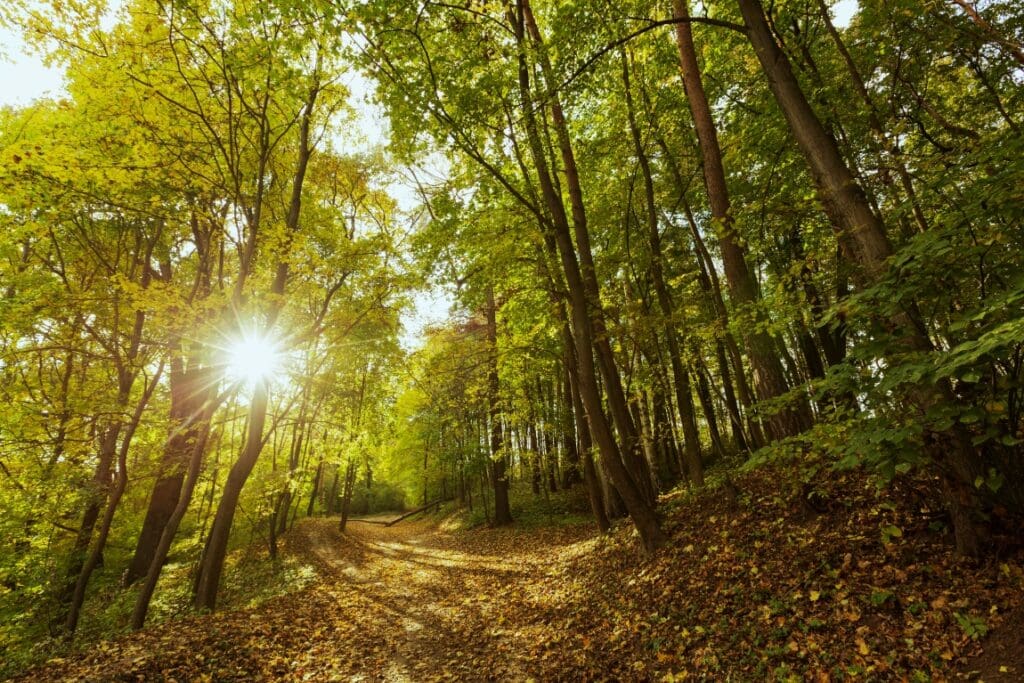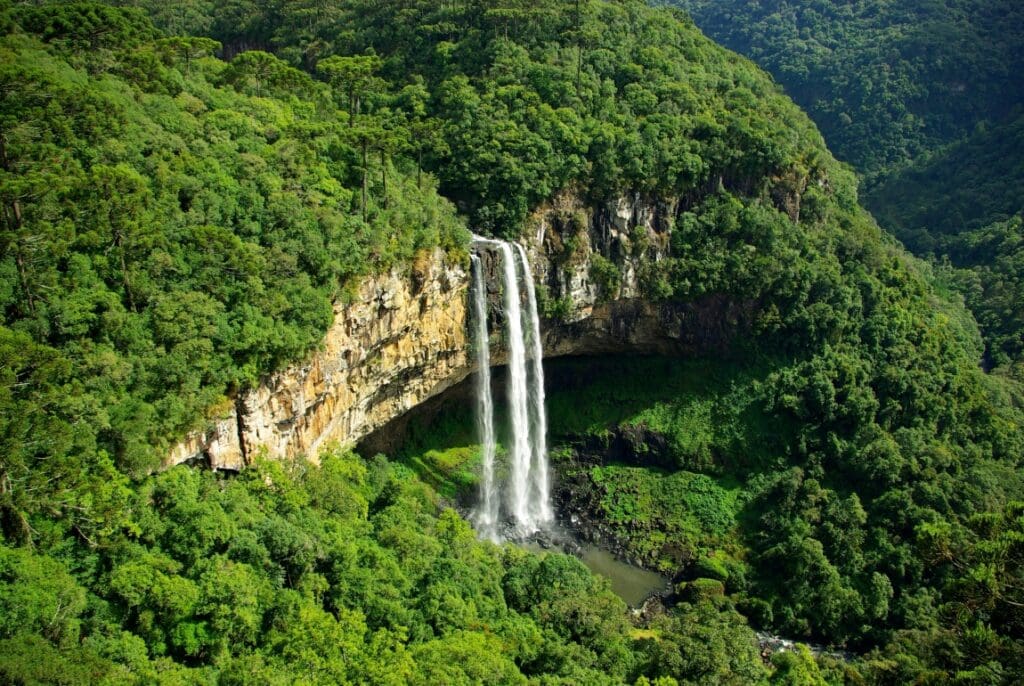Explore the latest insights from top science journals in the Muser Press daily roundup (July 30, 2025), featuring impactful research on climate change challenges.
In brief:
Why animals are a critical part of forest carbon absorption
A lot of attention has been paid to how climate change can drive biodiversity loss. Now, MIT researchers have shown the reverse is also true: Reductions in biodiversity can jeopardize one of Earth’s most powerful levers for mitigating climate change.
In a paper published in PNAS, the researchers showed that following deforestation, naturally-regrowing tropical forests, with healthy populations of seed-dispersing animals, can absorb up to four times more carbon than similar forests with fewer seed-dispersing animals.
Because tropical forests are currently Earth’s largest land-based carbon sink, the findings improve our understanding of a potent tool to fight climate change.
“The results underscore the importance of animals in maintaining healthy, carbon-rich tropical forests,” says Evan Fricke, a research scientist in the MIT Department of Civil and Environmental Engineering and the lead author of the new study. “When seed-dispersing animals decline, we risk weakening the climate-mitigating power of tropical forests.”
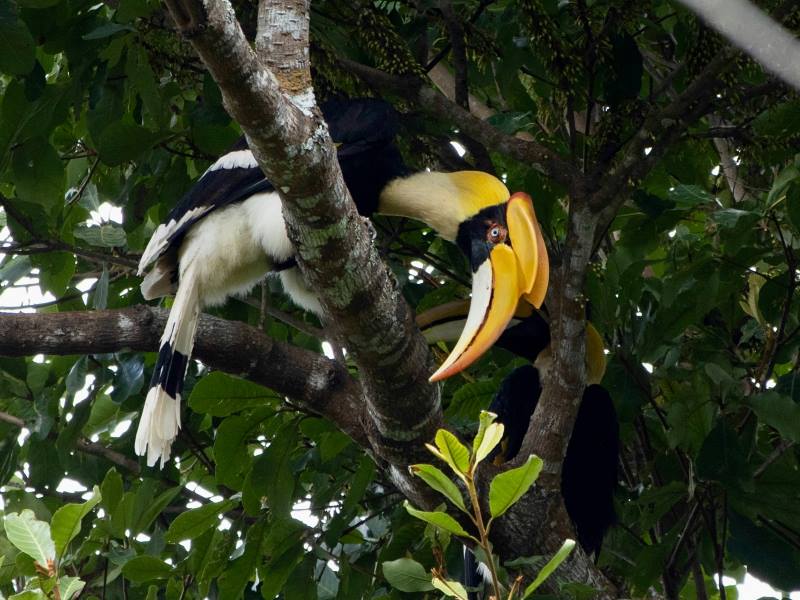
Fricke’s co-authors on the paper include César Terrer, the Tianfu Career Development Associate Professor at MIT; Charles Harvey, an MIT professor of civil and environmental engineering; and Susan Cook-Patton of The Nature Conservancy.
The study combines a wide array of data on animal biodiversity, movement, and seed dispersal across thousands of animal species, along with carbon accumulation data from thousands of tropical forest sites.
The researchers say the results are the clearest evidence yet that seed-dispersing animals play an important role in forests’ ability to absorb carbon, and that the findings underscore the need to address biodiversity loss and climate change as connected parts of a delicate ecosystem rather as separate problems in isolation.
“It’s been clear that climate change threatens biodiversity, and now this study shows how biodiversity losses can exacerbate climate change,” Fricke says. “Understanding that two-way street helps us understand the connections between these challenges, and how we can address them. These are challenges we need to tackle in tandem, and the contribution of animals to tropical forest carbon shows that there are win-wins possible when supporting biodiversity and fighting climate change at the same time.”
Putting the pieces together
The next time you see a video of a monkey or bird enjoying a piece of fruit, consider that the animals are actually playing an important role in their ecosystems. Research has shown that by digesting the seeds and defecating somewhere else, animals can help with the germination, growth, and long-term survival of the plant.
Fricke has been studying animals that disperse seeds for nearly 15 years. His previous research has shown that without animal seed dispersal, trees have lower survival rates and a harder time keeping up with environmental changes.
“We’re now thinking more about the roles that animals might play in affecting the climate through seed dispersal,” Fricke says. “We know that in tropical forests, where more than three-quarters of trees rely on animals for seed dispersal, the decline of seed dispersal could affect not just the biodiversity of forests, but how they bounce back from deforestation. We also know that all around the world, animal populations are declining.”
Regrowing forests is an often-cited way to mitigate the effects of climate change, but the influence of biodiversity on forests’ ability to absorb carbon has not been fully quantified, especially at larger scales.
For their study, the researchers combined data from thousands of separate studies and used new tools for quantifying disparate but interconnected ecological processes. After analyzing data from more than 17,000 vegetation plots, the researchers decided to focus on tropical regions, looking at data on where seed-dispersing animals live, how many seeds each animal disperses, and how they affect germination.
The researchers then incorporated data showing how human activity impacts different seed-dispersing animals’ presence and movement. They found, for example, that animals move less when they consume seeds in areas with a bigger human footprint.

Combining all that data, the researchers created an index of seed-dispersal disruption that revealed a link between human activities and declines in animal seed dispersal. They then analyzed the relationship between that index and records of carbon accumulation in naturally regrowing tropical forests over time, controlling for factors like drought conditions, the prevalence of fires, and the presence of grazing livestock.
“It was a big task to bring data from thousands of field studies together into a map of the disruption of seed dispersal,” Fricke says. “But it lets us go beyond just asking what animals are there to actually quantifying the ecological roles those animals are playing and understanding how human pressures affect them.”
The researchers acknowledged that the quality of animal biodiversity data could be improved and introduces uncertainty into their findings. They also note that other processes, such as pollination, seed predation, and competition influence seed dispersal and can constrain forest regrowth. Still, the findings were in line with recent estimates.
“What’s particularly new about this study is we’re actually getting the numbers around these effects,” Fricke says. “Finding that seed dispersal disruption explains a fourfold difference in carbon absorption across the thousands of tropical regrowth sites included in the study points to seed dispersers as a major lever on tropical forest carbon.”
Quantifying lost carbon
In forests identified as potential regrowth sites, the researchers found seed-dispersal declines were linked to reductions in carbon absorption each year averaging 1.8 metric tons per hectare, equal to a reduction in regrowth of 57 percent.
The researchers say the results show natural regrowth projects will be more impactful in landscapes where seed-dispersing animals have been less disrupted, including areas that were recently deforested, are near high-integrity forests, or have higher tree cover.
“In the discussion around planting trees versus allowing trees to regrow naturally, regrowth is basically free, whereas planting trees costs money, and it also leads to less diverse forests,” Terrer says. “With these results, now we can understand where natural regrowth can happen effectively because there are animals planting the seeds for free, and we also can identify areas where, because animals are affected, natural regrowth is not going to happen, and therefore planting trees actively is necessary.”
To support seed-dispersing animals, the researchers encourage interventions that protect or improve their habitats and that reduce pressures on species, ranging from wildlife corridors to restrictions on wildlife trade. Restoring the ecological roles of seed dispersers is also possible by reintroducing seed-dispersing species where they’ve been lost or planting certain trees that attract those animals.
The findings could also make modeling the climate impact of naturally regrowing forests more accurate.
“Overlooking the impact of seed-dispersal disruption may overestimate natural regrowth potential in many areas and underestimate it in others,” the authors write.
The researchers believe the findings open up new avenues of inquiry for the field.
“Forests provide a huge climate subsidy by sequestering about a third of all human carbon emissions,” Terrer says. “Tropical forests are by far the most important carbon sink globally, but in the last few decades, their ability to sequester carbon has been declining. We will next explore how much of that decline is due to an increase in extreme droughts or fires versus declines in animal seed dispersal.”
Overall, the researchers hope the study helps improves our understanding of the planet’s complex ecological processes.
“When we lose our animals, we’re losing the ecological infrastructure that keeps our tropical forests healthy and resilient,” Fricke says.
The research was supported by the MIT Climate and Sustainability Consortium, the Government of Portugal, and the Bezos Earth Fund.
Journal Reference:
E.C. Fricke, S.C. Cook-Patton, C.F. Harvey & C. Terrer, ‘Seed dispersal disruption limits tropical forest regrowth’, Proceedings of the National Academy of Sciences U.S.A. 122 (30) e2500951122 (2025). DOI: 10.1073/pnas.2500951122
Article Source:
Press Release/Material by Zach Winn, MIT News | Massachusetts Institute of Technology (MIT)
Deep heat beneath the United States traced to ancient rift with Greenland
A large region of unusually hot rock deep beneath the Appalachian Mountains in the United States could be linked to Greenland and North America splitting apart 80 million years ago, according to new research led by the University of Southampton.
The scientists argue it is not, as has long been believed, the result of plate tectonic movements causing the continent of North America to break away from Northwest Africa 180 million years ago.
The hot zone in question is the Northern Appalachian Anomaly (NAA), a 350-kilometre-wide region of anomalous hot rock that sits about 200 km beneath the Appalachian Mountains in New England.
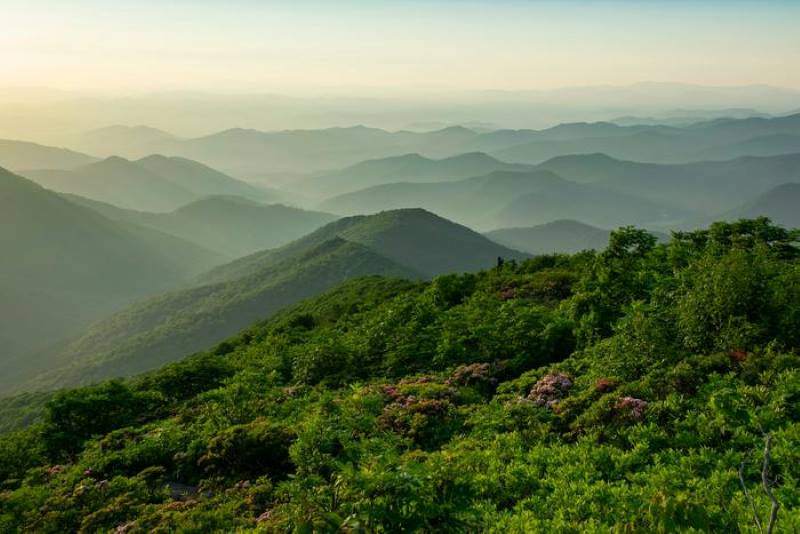
The research, published in the journal Geology, suggests the NAA in fact developed about 1,800 km from where it is now, when the Earth’s crust began to break apart near the Labrador Sea between Canada and Greenland.
Over time, this area of hot, unstable rock deep under the Earth’s surface has slowly moved to where it is today – at a rate of approximately 20 km per million years.
The research was undertaken by the University of Southampton in the UK, the Helmholtz Centre for Geosciences in Potsdam (GFZ), Germany, and the University of Florence in Italy.
Tom Gernon, lead author of the study and Professor of Earth Science at the University of Southampton, said: “This thermal upwelling has long been a puzzling feature of North American geology. It lies beneath part of the continent that’s been tectonically quiet for 180 million years, so the idea it was just a leftover from when the landmass broke apart never quite stacked up.
“Our research suggests it’s part of a much larger, slow-moving process deep underground that could potentially help explain why mountain ranges like the Appalachians are still standing. Heat at the base of a continent can weaken and remove part of its dense root, making the continent lighter and more buoyant, like a hot air balloon rising after dropping its ballast. This would have caused the ancient mountains to be further uplifted over the past few million years.”
‘Mantle wave’ theory
The scientists turned to a new idea they recently proposed called ‘mantle wave’ theory, which was recognised as a finalist for Science magazine’s 2024 Breakthrough of the Year.
The theory describes how hot, dense rock slowly peels away from the base of tectonic plates – much like blobs in a lava lamp – after continents break apart. These ‘waves’ ripple along the lower surfaces of the continents over tens of millions of years and can help explain rare volcanic eruptions that bring diamonds to the surface, and why some inland regions are unusually high.
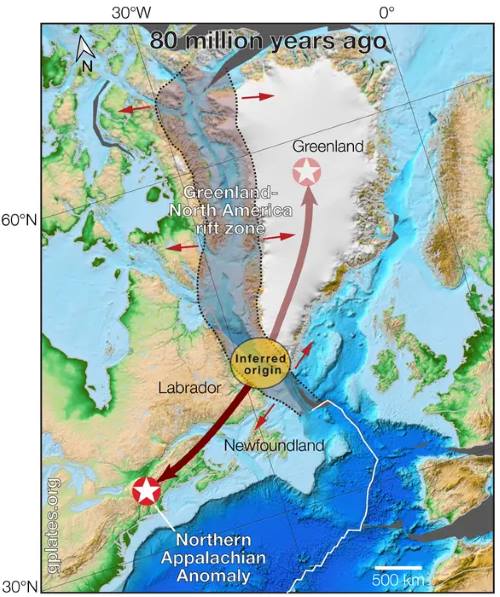
Using advanced geodynamic simulations, seismic tomography data (like a medical ultrasound, but using seismic waves to image Earth’s interior) and tectonic plate reconstructions, the research team traced the likely origin of the NAA to the breakup of the Labrador Sea, which occurred between 90 and 80 million years ago when Greenland separated from Canada.
Professor Sascha Brune, co-author of the study who leads the Geodynamic Modelling Section at GFZ in Potsdam, Germany, said: “These convective instabilities cause chunks of rock, several tens of kilometres thick, to slowly sink from the base of the Earth’s outer layer known as the lithosphere. As the lithosphere thins, hotter mantle material rises to take its place, creating a warm region known as a thermal anomaly.
“Our earlier research shows that these ‘drips’ of rock can form in series, like domino stones when they fall one after the other, and sequentially migrate over time. The feature we see beneath New England is very likely one of these drips, which originated far from where it now sits.”
If correct, the NAA has likely been slowly migrating south-westward across the North American lithosphere at a rate of approximately 20 kilometres per million years, which is broadly consistent with independent geodynamic predictions. The NAA’s current size (roughly 350 km across) and depth align closely with what models predict for such migrating instabilities.
Based on the team’s research, the centre of the anomaly is estimated to pass beneath the New York region within the next 15 million years.
A mirror of the NAA
The study also proposes that a similar anomalous hot zone beneath north-central Greenland may share the same origin, making it effectively a mirror image twin of the NAA – having emerged from the opposite flank of the Labrador Sea as it drifted apart.
Beneath Greenland, this thermal anomaly contributes to elevated heat flow at the base of the kilometres-thick ice sheet, influencing how the ice moves and melts today.
In this way “ancient heat anomalies continue to play a key role in shaping the dynamics of continental ice sheets from below,” said Professor Gernon.
Dr Derek Keir, study co-author and tectonics expert at the University of Southampton and the University of Florence, said: “The idea that rifting of continents can cause drips and cells of circulating hot rock at depth that spread thousands of kilometres inland makes us rethink what we know about the edges of continents both today and in Earth’s deep past.”
The team’s findings build on research indicating that deep Earth processes can continue to unfold for many tens of millions of years after surface plate boundaries have ceased to be active.
These long-lived instabilities can shape everything from regional uplift to patterns of volcanism and erosion, even across parts of the continental interiors previously thought to be geologically stable.
Professor Gernon added: “Even though the surface shows little sign of ongoing tectonics, deep below, the consequences of ancient rifting are still playing out. The legacy of continental breakup on other parts of the Earth system may well be far more pervasive and long-lived than we previously realised.”
Journal Reference:
Thomas M. Gernon, Sascha Brune, Thea K. Hincks, Derek Keir, ‘A viable Labrador Sea rifting origin of the Northern Appalachian and related seismic anomalies’, Geology (2025). DOI: 10.1130/G53588.1
Article Source:
Press Release/Material by University of Southampton
Risk of deadly diarrheal diseases in children set to worsen as climate changes
Diarrhoea remains one of the most serious health threats to young children in the Global South, and new research shows that climate change is set to worsen the risk substantially. However, improved access to education and targeted health policies could help families protect their children from this deadly disease.
Published in the scientific journal Environmental Research, this is one of the first large-scale studies to examine how long-term climate, socio-economic, and maternal and child health factors intersect to affect the risk of acquiring diarrhoea.
This study shows that rising temperatures and unusually drier rainy seasons – both hallmarks of climate change – are expected to increase the risk of diarrhoeal diseases across South and Southeast Asia, posing serious health threats to millions of children.

Although preventable and treatable, diarrhoeal diseases currently claim hundreds of thousands of child lives every year, predominantly in low- and middle-income countries. Increasing the use of measures known to limit the spread of the causal infections can help counter the expected increases in mortality from climate change.
Led by Dr Hira Fatima formerly of Flinders University, researchers including Prof Corey Bradshaw from Flinders, and Dr Melinda Judge and Prof Peter Le Souef from The Kids Research Institute Australia and the University of Western Australia, analysed observations of more than 3 million children in eight Asian countries, and highlighted temperature extremes and declining rainfall as the two main climate-associated drivers of higher risk of children getting diarrhoea.
Dr Fatima says the results make it clear that maternal education on good hygiene practices, the importance of breastfeeding, and recognising the symptoms of diarrhoea are the most effective ways to reduce diarrhoea in children in South and Southeast Asia.
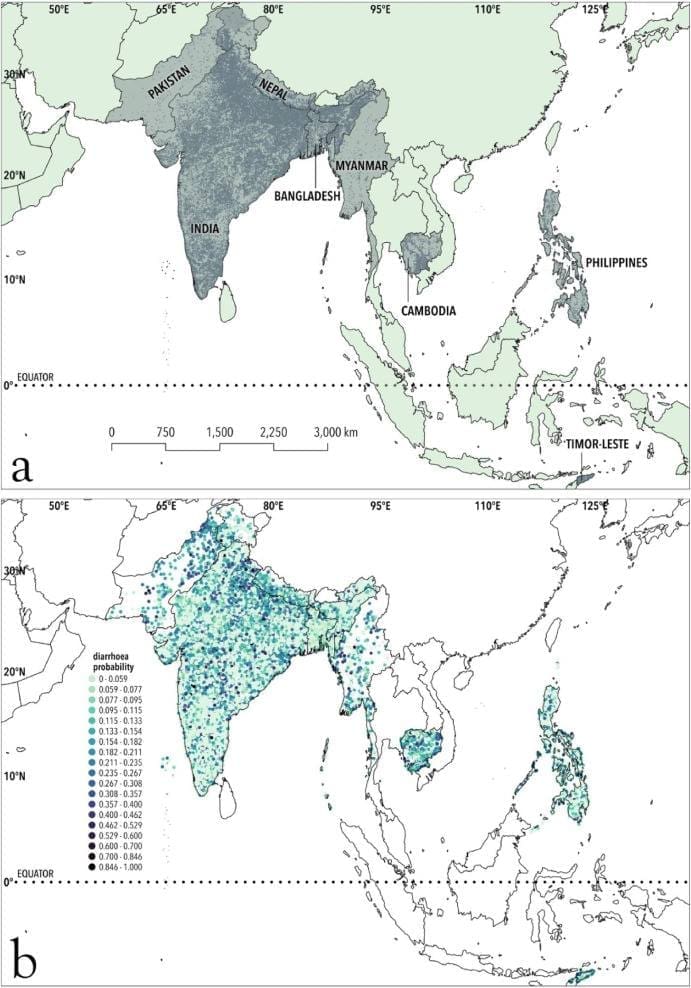
“Children of mothers with less than eight years of schooling faced an 18% higher risk of diarrhoea,” said Dr Fatima. “This makes investing in maternal education one of the most powerful and scalable climate-adaptation strategies – not only to improve child health, but also to address broader challenges like overcrowding and poor hygiene. Education empowers mothers to act early when their children fall ill, which can save lives.
“Education is not only a United Nations Sustainable Development Goal, but also a powerful tool for climate adaptation that must be central to climate-health policies, particularly in densely populated, high-risk regions of the world.”
Co-author, Professor Corey Bradshaw says the modelling shows that temperature swings of 30 to 40 °C increased diarrhoea risk by 39%, while drier rainy seasons raised the risk by 29%.
“Our modelling emphasises that we need to develop and implement climate-related health policies that protect children under five years old from this increasing health risk,” said Professor Bradshaw.
“Around 88% of diarrhoeal deaths are linked to unsafe drinking water and related causes. Improved access to drinking water can reduce the risk of diarrhoea by 52%, while better sanitation facilities can lower the risk by 24%. We know that poverty increases the risk of diarrhoea by limiting access to nutritious food, clean water, and healthcare, while also fostering environments where diarrhoeal pathogens thrive.
“With our recent research also showing that droughts in East Asia will intensify based on 150,000 years of monsoon records, this new study now warns that the intensified impacts of climate change will lead to increased child diarrhoea and all the associated health impacts in Asia.
“To build resilience against the growing impacts of climate change, the researchers urge governments to prioritise expanding access to maternal education – particularly through child health programs – while also investing in safe water systems and addressing overcrowding through improved housing and infrastructure policy.”
Dr Melinda Judge says that despite contributing the least to climate change, low- and middle-income countries will continue to experience a higher burden of childhood diarrhoeal disease because of it. Specific child health impacts due to climate change must be acknowledged and addressed.
Professor Peter Le Souëf says that as climate change accelerates, child health outcomes will worsen if measures are not put into place to counter the predicted increase in diarrhoea cases.
Journal Reference:
Syeda H. Fatima, Melinda A. Judge, Peter N. Le Souëf, Corey J.A. Bradshaw, ‘Impact of climate change on diarrhoea risk in low- and middle-income countries’, Environmental Research online, 122412 (2025). DOI: 10.1016/j.envres.2025.122412
Article Source:
Press Release/Material by Yaz Dedovic | Flinders University
Optimizing geothermal foundations in soft clay for urban buildings
As urbanization increases and climate changes accelerate, there is an urgent need for sustainable and space-efficient solutions for heating and cooling in buildings. One promising solution is to use energy piles — concrete foundation systems that also serve as heat exchangers using geothermal energy. However, in high-density cities like Tokyo, Bangkok, and Manila, where buildings are often constructed on soft clay foundations, engineers face unique challenges in designing these energy piles.
In this context, a research team led by Professor Shinya Inazumi from the College of Engineering, Shibaura Institute of Technology, Japan, has come up with an innovative framework to improve the design and performance of energy piles, especially in soft clay soils. This study was made available online on June 27, 2025, and was published in Volume 73 of the journal Case Studies in Thermal Engineering.
Energy piles are concrete foundation elements with embedded U-shaped pipes that circulate heat transfer fluids within them. These heat transfer fluids exchange thermal energy with the surrounding ground. When these elements are connected to ground source heat pumps (GSHPs), they can efficiently heat and cool buildings by using the stable underground temperatures. GSHPs are known to maintain high performance even in fluctuating surface temperatures, unlike conventional air-source heat pumps, which are less efficient in extreme weather — making GSHPs an ideal solution for extreme temperature climates.
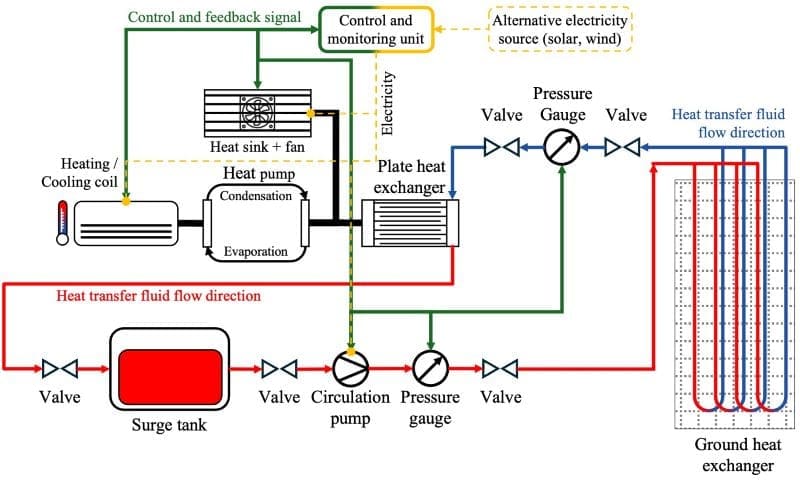
While GSHPs increase efficiency, energy pile systems encounter several challenges. In most cities, soft clay soils are used for construction; these soils are characterized by low permeability (resistance to water flow) and low thermal conductivity (difficulty in transferring heat). In such cases, the accumulation of heat over time can lead to a phenomenon called thermal interference that reduces the efficiency of the entire system.
To encounter this, the researchers used a combined computational and experimental approach and developed a three-dimensional heat transfer model. Using finite element models (FEM) via COMSOL Multiphysics, a physics-based simulation software, the researchers modeled heat transfer around energy piles embedded in soft clay. These simulations were then calibrated using real-world data obtained from a test site in Bangkok. The model analyzed several pile groupings ranging from one to nine piles, which operated under various daily time cycles (8 to 24 hours).
“We developed a simplified prediction model to help engineers improve energy pile design without the need for expensive computational resources or specialized expertise,” says Prof. Inazumi.
The results revealed several insights on the performances of the energy piles. Firstly, the grouped configurations exhibited measurable thermal interference, with soil temperatures rising from 2.18% to 15.43% around the closely spaced piles. Estimating this interference at the design stage was considered critical as it can diminish the system’s efficiency.
“To simplify the process, we introduced practical multiplier factors that allow engineers to predict thermal behavior using single-pile simulations,” explains Prof. Inazumi.
The multiplier factors range from 1.6498 to 2.9119 and could be applied to the results obtained from single-pile simulations, allowing engineers to predict the performance of larger pile groups without the need for complex three-dimensional models. This dramatically reduces the need for full-scale FEM runs, offering a quick, accessible method for thermal performance estimation.
The study also noted that reducing operational hours could delay the temperature saturation (when the soil becomes too warm to absorb more heat) by 103 hours. Additionally, reducing the operational hours also decreased the peak soil temperatures by 29% over 5 years. Another critical finding was that the piles at the center get hotter in comparison to those at the edge, suggesting the effect of crowding. These insights suggest that the design of energy pile groups can be optimized by using the provided multipliers and temperature maps. This optimization strategy can help maintain structural integrity and extend the system’s lifespan.
The model has significant potential for real-world applications. It is essentially relevant for engineers working in rapidly urbanizing cities built on soft soils, where traditional heating, ventilation, and air conditioning systems are both energy-intensive and climate-vulnerable. By offering easy-to-use simulation shortcuts validated with real-world data, this research lowers the entry barrier for adopting geothermal systems in Southeast Asia and beyond, paving the way for a cleaner, and sustainable future.
“Our study, by demonstrating the viability and affordability of geothermal energy systems for dense urban environments, addresses the challenges in regional development, contributing to the global climate agenda,” concludes Prof. Inazumi.
Journal Reference:
Thiti Chanchayanon, Susit Chaiprakaikeow, Apiniti Jotisankasa, Shinya Inazumi, ‘Integrated computational and experimental evaluation of thermal optimization in energy pile groups in soft clay’, Case Studies in Thermal Engineering 73, 106571 (2025). DOI: 10.1016/j.csite.2025.106571
Article Source:
Press Release/Material by Shibaura Institute of Technology
Featured image credit: Gerd Altmann | Pixabay



